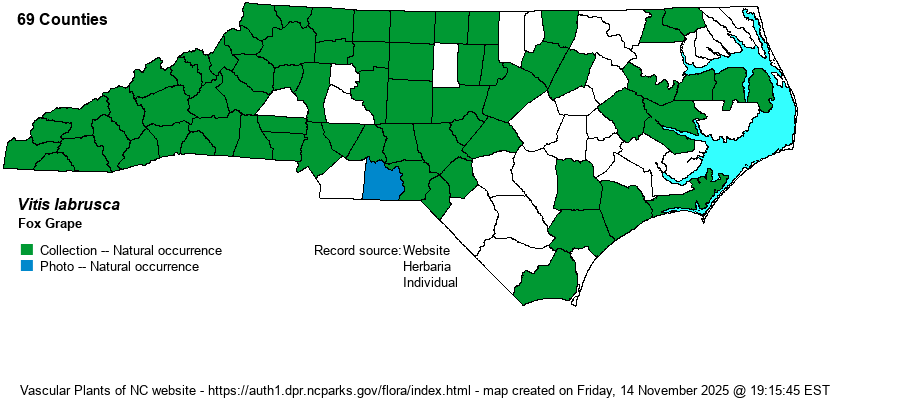| Author | L. | |
| Distribution | Present over essentially all of the Mountains and Piedmont; widely scattered over most of the Coastal Plain, but many counties there lack a record.
This is primarily a species of the Atlantic states, ranging from southeastern Canada south to central GA. The range is very spotty from OH and WI south through KY, TN, and AL west to LA and MO.
| |
| Abundance | Frequent to common in the Mountains; fairly common in the Piedmont. Rare to uncommon in the Coastal Plain, though perhaps simply under-collected in this province; abundances of several grape species in the Coastal Plain need better clarity. Seemingly more numerous toward the coast rather than farther inland in the Coastal Plain, possibility a collecting bias but perhaps reflecting a preference for higher pH soils. | |
| Habitat | This is primarily a species or rich forests, especially in bottomlands and moist slopes, including thickets and opening in such forests. |
| Phenology | Flowers from May to June, and fruits from September to October. | |
| Identification | This is another high-climbing, deciduous, woody vine, with large leaves that typically have three lobes, the side lobes usually small. The leaves are usually about 6 inches long and wide. Identification of this grape is usually made by the densely pubescent leaves below, often with rusty hairs (giving a buff-colored look to the undersides). In addition, there are tendrils or inflorescences opposite at least three consecutive leaves. Check keys for additional characters. Along with V. aestivalis, V. baileyana, and V. vulpina, this is another numerous grape of bottomlands in the western two-thirds of the state. | |
| Taxonomic Comments | Older references often listed varieties for this species, but most recent ones do not.
Owing to difficulty of identification of nearly all Vitis species from photographs, for now no iNaturalist photo reports are included on the range maps. In fact, very few of these have been given a Research Grade status of approval by an expert. | |
| Other Common Name(s) | None | |
| State Rank | S4 | |
| Global Rank | G5 | |
| State Status | | |
| US Status | | |
| USACE-agcp | FAC link |
| USACE-emp | FACU link |

